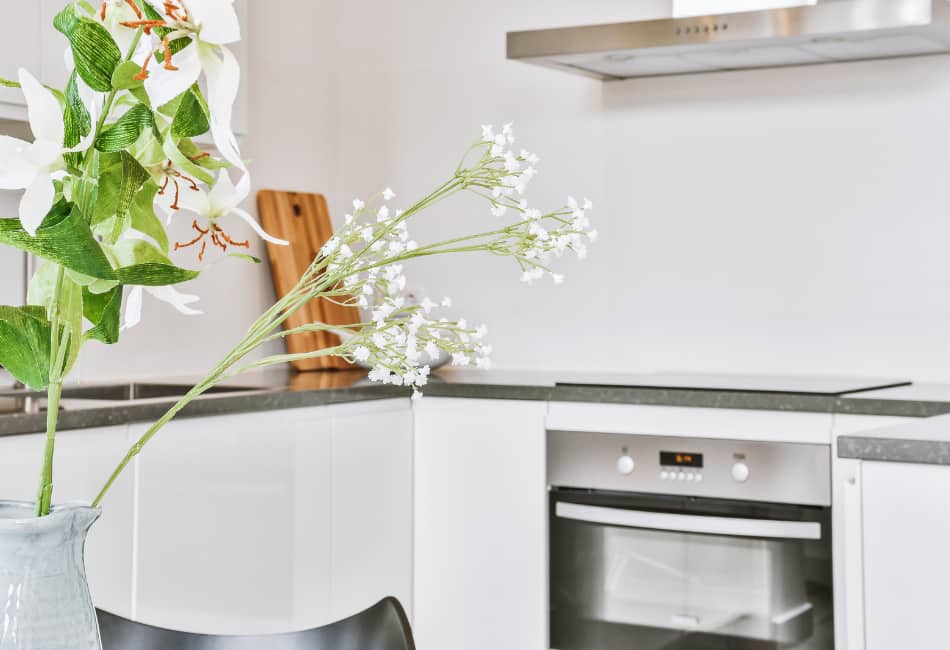If you’ve ever had a lily pollen stain on your countertop, whether it’s quartz, marble, granite, wood, or other countertop materials, you know how difficult they can be to remove. Lily pollen is notorious for being one of the most stubborn stains around.
This article will discuss several methods for removing lily pollen stains from all of the different countertop materials. We’ll also cover some preventative measures that can be taken to avoid them in the first place.
Removing Lily Pollen Stains From Countertops
Lily pollen stains from countertops are very common due to the popularity of lilies as a flower. They are often given as gifts or used in floral arrangements.
The first step in removing any type of stain is to identify the material of the countertop. This will determine what type of cleaner and/or solvent can be used without damaging the surface.
Once the material is determined, you can begin to treat the stain using one of the following methods:
1. How To Remove Lily Pollen Stains From Quartz Countertops
If you have a quartz countertop, you’re in luck. Quartz is one of the most accessible materials to clean and is also very resistant to staining.
If you have lily pollen stains on quartz countertops, you can rest assured that the lily stains will not penetrate the quartz countertop, making it relatively easy to remove.
To remove the lily pollen stains from your quartz countertops, here’s the process you will need to follow:
Step One:
- Vacuum the area to remove any loose lily pollens.
- If you do not have a vacuum cleaner, you can use a sticky take or a lint roller.
- Then, simply tape or roll over the area to pick up any loose pollen.
Step Two:
- Next, mix equal parts rubbing alcohol or white vinegar and cold water.
- You want to do your mixture in a spray bottle.
Step Three:
- Spritz a fine mist of the mixture over the lily pollen stains.
- Allow the mixture to sit for a few minutes so it can start to break down the pollen.
Step Four:
- Once the mixture has had time to work, take a sponge or scrub brush and gently scrub the area in a circular motion.
- You may need to do this several times to remove all of the pollen.
Step Five:
- Once the stain is gone, wash the area with a mixture of mild dish soap and warm water.
- This will help to remove all of the rubbing alcohol or white vinegar residue.
Step Six:
- Rinse the area with cold water and dry it with a clean cloth.
There you have it! Your quartz countertop should now be free of any lily pollen stains. You can also check out a comprehensive step-by-step guide I wrote earlier on how to remove lily pollen stains from quartz countertops. I highlighted six home remedies you can use to remove lily pollen from your quartz countertops with ease.
2. How To Remove Lily Pollen Stains From Marble Countertops
I will talk about two basic ways you can remove lily pollen stains from your marble countertops. The first method involves using hydrogen peroxide and an ammonia solution, while the second method involves poultice. Here are the details on how to use both of these methods;
Method 1: Using Hydrogen Peroxide & Ammonia Solution
Unlike quartz countertops, when marble countertops are stained with lily pollen, the pollen can actually penetrate into the surface of the marble.
This is because marble countertops are porous, especially if it hasn’t been properly sealed. This makes removing lily stains from marble countertops a bit more difficult than other materials.
But there is still a way to get rid of the pollen stains – it just takes a little bit more elbow grease. To remove lily pollen stains from your marble countertop, here’s the process you will need to follow:
Step One:
- Start by vacuuming the area to remove any loose lily pollen.
- Then, just like in the first method, if you don’t have a vacuum, you can use a sticky tape or a lint roller.
- This step is very important because you do not want to remove as much of the lily pollen stains from the marble without driving it further deeper into the pores of the marble.
Step Two:
- Next, mix a solution of 1/4 cup hydrogen peroxide and 4-5 drops of ammonia in a bowl.
- Both these two chemical ingredients are important in helping to break down and remove the lily pollen stains.
- They contain bleaching properties that will help to lift the stains from the surface of the marble.
- Just be careful not to use too much hydrogen peroxide as it can actually damage or etch the surface of your marble countertop.
Step Three:
- Apply the mixture to the lily pollen stains using a clean cloth or sponge.
- Allow the mixture to sit on the stains for about 15-20 seconds.
- This will give it enough time to break down the pollen stains and lift the stains from the surface of your marble countertop without ruining it.
Step Four:
- After a few seconds, use a clean sponge or brush and scrub the area in a circular motion.
- You may need to do this a few times to remove all of the pollen stains.
Step Five:
- Once the stain is gone, clean the marble surface with a mild dish soap solution.
- Rinse the area with clean water and dry it with a soft cloth.
- You should now see a significant difference in the appearance of your marble countertop.
- If the lily pollen stains are still visible, you may need to repeat the process a few more times.
Using hydrogen peroxide and ammonia solution is a great way to remove lily pollen stains from your marble countertop (especially from sealed marble) without damaging it. Also, this method works well on granite countertops.
Method 2: Using Poultice (Hydrogen Peroxide And Talcum Powder)
While using the hydrogen peroxide and ammonia solution would do such an awesome job at removing lily pollen stains from marble countertops that have been sealed, using poultice consisting of hydrogen peroxide and talcum powder is a better solution to remove lily pollen stains from unsealed marble countertops.
Poultice works great in drawing out deep-seated stains, including lily pollen stains from porous surfaces like unsealed marble countertops. Poultice is a pasty mixture that is applied to a stained area and left to dry. To use this method, here’s what you need to do:
Step One:
- Start by mixing a solution of hydrogen peroxide and talcum powder into a pasty consistency.
- The ratio you’ll want to use is three parts of hydrogen peroxide to one part of talcum powder.
- So, if you’re using a cup of hydrogen peroxide, you’ll need about a quarter cup of talcum powder.
- Instead of talc powder, you can also use cornstarch or baking soda.
Step Two:
- Once you’ve mixed the ingredients together, apply them directly to the lily pollen stains.
- Make sure to cover the entire stained area with a thick layer of the poultice mixture.
Step Three:
- Next, cover the poultice application with a plastic wrap so that it doesn’t dry out too quickly.
- You can also use a damp cloth if you don’t have a plastic wrap.
Step Four:
- Allow the poultice to sit on the lily pollen stains for about 24 hours so that it has enough time to work its magic.
- After 24 hours, remove the plastic wrap (or damp cloth) and allow the poultice to dry completely.
- The poultice will suck the lily pollen stains from the marble even if it has had time to seep in.
Step Five:
- Once the poultice has dried, use a putty knife to scrape off the dried poultice from the surface of your marble countertop.
Step Six:
- Finally, clean the area with a damp cloth and clean water.
- You can also use a marble cleaner at this point if you have one at hand.
- Rinse the marble surface with clean water and follow up with a dry soft cloth to remove any residue.
- Allow the marble countertop surface to air-dry.
Both methods are great ways to remove lily pollen stains from your marble countertop without damaging it. Try both methods and see which one works better for you.
3. How To Remove Lily Pollen Stains From Granite Countertops
If you have a granite countertop, you should know granite is not as porous as marble. So, using hydrogen peroxide and ammonia solution or poultice will not do any harm to your granite countertop.
In fact, these two methods are some of the best ways to remove lily pollen stains from granite countertops without damaging them.
Just follow the steps given above for each method, and you should be able to remove the lily pollen stains from your granite countertop with ease.
But there is another method that tends to do a fantastic job at removing lily pollens from granite countertops, such as rubbing alcohol. Here’s how to go about it;
Step One:
- Vacuum, tape, or use a lint roller to remove any loose lily pollen from the surface of your granite countertop.
Step Two:
- Mix equal parts rubbing alcohol and water in a bowl.
Step Three:
- Dip a clean cloth into the solution and wring it out so that it’s damp but not dripping wet.
Step Three:
- Rub the lily pollen stains with the damp cloth in a circular motion until the stains start to fade away.
- You may need to apply some elbow grease to really get rid of the stains.
Step Four:
- Once the lily pollen stains are gone, rinse the area with clean water and dry it off with a soft cloth.
- Your granite countertop should be ready for use in no time!
Final Thoughts
In conclusion, we discussed how to remove lily pollen stains from different countertop materials without damaging them.
So, whether you have a quartz, marble, or granite countertop, you should be able to remove those pesky lily pollen stains in no time! Thanks for reading, and good luck!

